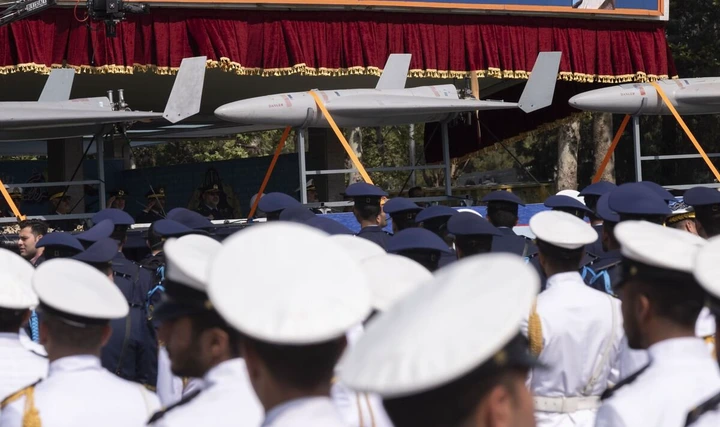
Kamikaze drones form a backdrop for this Iranian soldier (Image: Getty)
Britain is examining the remains of one of Iran’s most top secret kamikaze drones after a spectacular blunder by the Islamic regime allowed it to fall into Western hands.
It comes as the US, the UK and Israel’s leading allies prepare to issue further sanctions against Tehran following last weekend’s long-range missile against Israel
Crucially, fresh sanctions may also be levied against any country – including China – found to be supplying components for Iran’s killer drones.
A large surviving part of the Arash-2 drone was recovered in the Negev desert last Sunday. The discovery was both unusual and unexpected because the UAV’s large warhead means that it usually disintegrates upon impact.
That it survived relatively intact means that either the drone was launched without a warhead, or that the warhead malfunctioned – which, in itself, would be significant.
Its location suggests it had been aimed at one of Israel‘s largest air force bases at Nevatim, which usually hosts F-35s, surveillance aircraft and even the PM Benjamin Netanyahu’s official “Air Force One” plane.
Also known as the Kian 2, the Arash-2 UAV is one of Iran’s latest generation suicide drones and was originally designed to attack Israeli cities such as Tel Aviv and Haifa when it was revealed in 2022.
Not much is known about its inner workings, however, and Ministry of Defence scientists, engineers and technicians have now begun to pore through its remains at the Defence Science and Technology Laboratory at Porton Down, Wiltshire.
Iran claims that the loitering drone has a range of 2,000 km – enabling it to comfortably hit Israeli targets – and its large warhead means it is more deadly than Iran’s Shahed-136 drone, which provided the backbone of last weekend’s attack.
The Shahed-136 – repackaged by Russia as the “Geran-2” – is being used extensively in the war in Ukraine.
Flying at around 120 mph, the drone’s two-stroke engine is so noisy that it has been nicknamed “the moped”.
Ukrainians authorities claimed that the faster Arash-2 is also being used by Russian forces in Ukraine.
But Iran has denied this – with officials revealing the sensitivity of the new technology by admitting to fears that giving it to Russia may see it fall into US and British hands.
Tehran’s decision to use it during last weekend’s attack against Israel has ended with the same result.
Though commanders in Iran’s Islamic Revolutionary Guard Corps (IRGC) Aerospace Force hoped its ability to fly low would evade Israel‘s Iron Dome, the Arash -2 – described as a cruise missile in all but speed – was shot down by a fighter jet.
It was not known whether this was one of the six RAF Typhoons attached to IX (Bomber) Squadron which took part in the defence of Israel.
But its recovery by UK and US forces is a spectacular backfire for Iran.
“Iran’s actions have presented us with a rare opportunity to examine this so-called kamikaze drone, which was found remarkably intact,” said one Whitehall source last night.


According to Israeli officials, Iran launched 170 drones, more than 30 cruise missiles and 120 ballistic missiles at 11.30pm local time last Saturday.
More than 99 percent of all Iranian projectiles were intercepted – either by Israeli forces , or with help from the US, UK. Jordan and Saudi Arabia.
But this included each of the 170 drones, teaching Tehran the lesson that cheaper drones which cost £10-£50K cannot replace more expensive cruise missiles.
Nevatim Air Force base was hit by one of the nine ballistic missiles that got through the air defence net, but it suffered only minor damage.
The remains of the drone were inspected by MoD technicians at RAF Akrotiri base in Cyprus, before being flown by transport aircraft to Brize Norton, from which they were taken by road to Porton Down.
Last night Justin Crump, ceo of Sibylline Strategic risk group, said: “This is a significant find.
“They will be trying to determine whether the drone is as sophisticated as the Iranians claim, whether it has any vulnerabilities which allow us to shut it down, and whether its components can be targeted in the form of extra sanctions.”
He added: “Iran’s decision to directly target Israel has put Tehran in the firing line, and for little gain.
“When. you add the recovery of this UAV into the mix, you begin to see how the strike was a bigger and more serious failure than Tehran would like to make out.”




